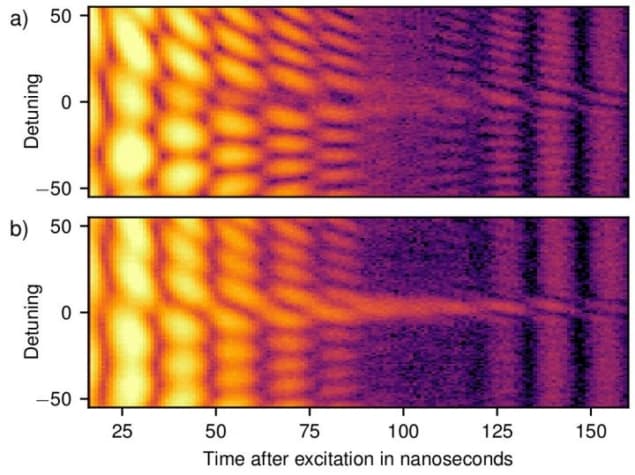
Scientists routinely use laser light to control how an atom’s electrons move from one electronic state to another, but controlling an atom’s nuclear state is far more challenging. Researchers at the Max Planck Institute for Nuclear Physics in Heidelberg, Germany, have now used X-ray light to achieve coherent control over nuclear excitations for the first time. As well as contributing to a better understanding of quantum matter, the work could hasten the development of technologies such as ultraprecise nuclear clocks and batteries that can store huge amounts of energy.
Atomic nuclei are quantum systems in which the component protons and neutrons can quantum-mechanically “jump” from one nuclear quantum state to another when they gain or lose energy. The energy differences in these nuclear jumps are often six orders of magnitude larger than the jumps made by electrons within an atom’s electron shells, says team member Christoph Keitel. “A single quantum jump made by a nuclear component can thus pump up to a million times more energy (into the states) – or get it out again,” he explains. “This has given rise to the idea of nuclear batteries with an unprecedented storage capacity.”
Keitel adds that the quantum states of some atomic nuclei are also much more sharply defined than electronic quantum states. This means the jump frequencies are also more precise – something that could, in principle, be exploited to create nuclear clocks that are far more precise than the atomic clocks used for today’s precision timekeeping and navigation. These ultra-precise clocks could also be useful for fundamental physics studies such as investigations of whether the known physical constants of nature are indeed constant.
Precisely addressing and controlling jumps
Before such applications see the light of day, however, researchers need to find some way of precisely addressing and controlling these jumps. One such technique, which the Heidelberg team has been working on for more than 10 years, involves high-energy X-ray light.
In the present work, researchers led by Jörg Evers used pulses of light from the Nuclear Resonance Beamline ID18 at the European Synchrotron Radiation Facility (ESRF) in Grenoble, France that they split into two using a “split-and-control unit”. The purpose of this unit is to delay one of these two pulses relative to the other.
Evers and colleagues sent the first pulse to a “test” target sample made from a stainless-steel foil 1μm thick. The steel in this foil is enriched to contain 95% of the “Mössbauer” isotope iron-57 (57Fe), which has a nuclear (magnetic dipole) transition at an energy of 14.4 keV. The second pulse follows the first after a time delay, and afterwards both pulses encounter the real sample. This sample is also made of stainless steel enriched with 57Fe atoms, but it is 2 μm thick.
Pushing a swing
The researchers explain that their first pulse contains a broad mix of frequencies and is extremely short-lived, lasting just 100 picoseconds (1 ps = 10-12 s). This pulse stimulates a quantum transition in the 57Fe atom nuclei. The second pulse is longer, at 141 nanoseconds, and its energy is precisely tuned to the same quantum transition. The time delay between the two pulses can be adjusted in a way that the researchers liken to pushing a person on a swing. While the first push causes the person to swing, or oscillate, back and forth, the second push either enhances the oscillation or slows it down depending on when it occurs within the oscillation’s phase. The second pulse is thus, respectively, either more constructive or more destructive for the quantum state.

Physicists measure energy of lowest nuclear excited state
Achieving such a tightly controlled change in the quantum dynamics of an atomic nucleus is a technical feat that took the Heidelberg team years to achieve. Among other factors, it requires the delay of the second pulse to be stable on a time scale of just a few zeptoseconds (1 zs = 10-21 s). Only then can the two pulses work together to control nuclear excitations.
Spurred on by these results, which they report in Nature, the researchers now plan to explore possible applications of their new control scheme. “These include novel spectroscopy approaches and adaptive X-ray optics,” Evers tells Physics World.
